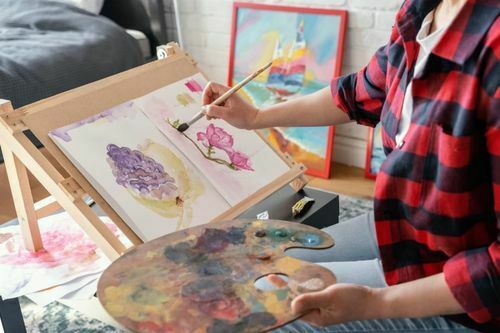Table of Contents
What is a portfolio for Fine Arts courses?
A portfolio for Fine Arts courses is a collection of the best artwork created by you. It serves as a visual walkthrough of your talent, experience, and arts background. Having an exceptional portfolio is quintessential if you wish to pursue Fine Arts courses.
Why is a portfolio for Fine Arts courses necessary?
A well-structured portfolio for Fine Arts courses can help assessors determine your skills and talent. It also helps decide whether or not you are a suitable candidate for the program. Portfolios are often required for admission to the undergraduate, certificate, and associate degrees. Keep reading to learn more about creating a perfect portfolio for your Fine Arts courses!
Steps to creating a remarkable portfolio for your Fine Arts courses

Your art portfolio needs to collectively represent your creativity, interests, abilities, and overall development as an artist. Regardless of whether you are a graphic designer, photographer, or illustrator, cracking the admission process to a good Fine Arts degree requires forethought.
#1. Do your research thoroughly
One of the first steps to putting together a portfolio for your fine arts course follows soon after deciding which art or design school you want to apply to. Here are a few things to keep in mind –
- You can consider applying to multiple colleges, significantly increasing your chances of securing admission to some of the top art schools.
- All fine arts schools will have a list of art portfolio requirements. These requirements can vary from school to school.
- Therefore, doing your research well in advance can help you comprehensively list what an art school’s portfolio requirements are.
- While doing your research, it is important to note application and portfolio due dates, size & format requirements.
- Also, note whether the universities accept finished pieces and whether the submissions need to be digital.
#2. Start early with building your portfolio
Once you have made a list of the top art schools you wish to join & their associated portfolio requirements, you can begin work on building the same –
- Start thinking about which media excites you the most and what your strengths are as an artist.
- Preparing your application early in the process can help you create a comprehensive collection of your talent.
- One of the best ways to work on and improve your portfolio is by considering outside opinions.
- Getting feedback on your collection from mentors, friends, and families can help you incorporate different ideas into your portfolio.
- It is precisely what a reputed art school will look for in its application submissions.
#3. Organize effectively

Here are a few tips for organizing your portfolio for Fine Arts courses effectively –
- Arrange different pieces creatively. It can significantly reflect your thought process and presentation skills.
- Keep an eye on the order in which you present your work. It helps plan the structure of your portfolio accordingly.
- Present your artwork in a way that helps admission counselors understand the narrative you are trying to establish.
- You can even consider arranging your artwork in increasing order of complexity and skillsets, which allow the authorities to identify how versatile your talents are.
#4. Write clear labels and descriptions
Most Fine Arts schools will have portfolio requirements that include basic information on your collection. Here’s how you can match those requirements –
- A standard format includes the title, date, and description of the medium that you have used for the artwork.
- If the art school requires more information, you can elaborate on the same without being excessive.
- It is also important to note that you may have to answer questions or explain different parts of your work.
- While you do not have to vividly memorize the details of your artwork in the portfolio, going through the same before a presentation can be helpful.
#5. Your notes should be critically written
While showcasing your technical skills is important, demonstrating remarkable storytelling skills is also quintessential. Here’s what you can do –
- The admissions committee should be able to identify the deeper meaning behind each artwork through the information you provide.
- Add notes to each artwork to help the concerned parties recognize your thought process and critical appraisal of your work.
- The notes that accompany should be able to explain what went ‘wrong’ just as clearly as what went ‘right.’
- You can demonstrate the same by displaying an earlier ‘draft’ version of a piece that you altered for the better.
- Your notes can also work wonders to express your opinion on art and culture.
- Be sure to discuss what you think your art is capable of in the notes.
#6. Include work from direct observation

- A portfolio for Fine Arts courses must include artwork from your direct observation.
- Direct observation is the process of creating pieces by observing all the real-life things around you.
- Examples of direct observation work can include rooms in your house, still-life, landscapes, self-portraits, and portraits of other people.
- However, it is important to note that direct observation does not include work that was created by looking at a copy of another artist’s work or a photograph.
#7. Be original
- Always be original. Your portfolio for Fine Arts courses should display your originality.
- The art you produce should not be mere copies of another artist’s work.
- Your portfolio should be able to showcase your personality, style, and uniqueness.
- One of the best ways to achieve this is by showcasing themes or techniques that you are passionate about.
- While not every piece you submit needs to have a particular theme, sticking to a relevant style can make your portfolio much more memorable.
Key takeaways
- Fine Arts is a discipline that needs creativity and imagination. It requires you to think out of the box.
- While creating your portfolio, this is something that you must always remember.
- Going through the requirements of portfolio for Fine Arts courses can help you create a collection of pieces that will be memorable.
- Ensure that your portfolio is powerful enough so that you can join your dream art school.
- After all, it can help you establish a career for yourself in this dynamic and lucrative industry.
- Construct an incredible portfolio showcasing all of your work with our simple and helpful guide!
Was this blog informative? If so, please share your thoughts in the comments below. Click here to reach out to us for more information on how to build a portfolio for Fine Arts courses. We would be happy to assist you with your queries!
Liked this blog? Then read 5 things you need to know about studying Fine Arts abroad!
FAQs
Question 1: How many examples of my work should I include in my portfolio?
Answer: While the exact number of pieces varies from university to university, most art schools request 10-20 samples of your work.
Question 2: Can I include time-based media in my portfolio?
Answer: Absolutely! Time-based media such as interactive website designs and moving images can be an excellent addition to your digital portfolio for Fine Arts courses.
Question 3: Should I include dates in my portfolio?
Answer: Yes, dates in your portfolio are often vital information that can help concerned authorities track your progress as an artist.







